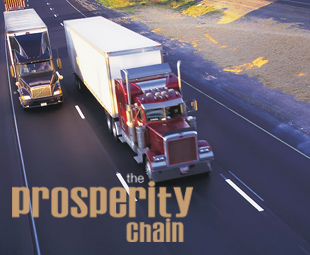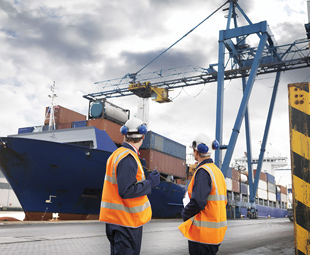The prosperity chain

After the financial meltdown of 2008, last year was all about survival for the commercial world. But at least 2010 is shaping up to be a year of tentative recovery. FOCUS looks at the role of supply chain management in this process. “Supply chains pervade every enterprise on the planet.” So says Hans Ittmann, executive director, Built Environment, Centre for Scientific and Industrial Research (CSIR). His statement encapsulates why supply chain management is so vital to the overall success of virtually every single business in the modern world.
“The overriding goal and objective of each and every supply chain is to transport, distribute and move products and services ever closer to final consumption in a more cost-effective way, adding value in the process. This requires dedication, creativity and innovation by all parties involved,” Ittmann explains.
Interestingly, it was the globalisation of physical supply chains in particular – and financial and information systems in general – that made the boom years prior to the recession possible.
According to Barloworld Logistics’ supplychainforesight 2010 survey, with globalisation it became commonplace to source, make and deliver products and services from anywhere to anywhere, all over the world. Unfortunately, the global organisational and management implications of this were often overlooked. Which is why focusing on survival and slashing costs as a supply chain response to the sub-prime and debt crises quickly resulted in a shrinking of operations and a shortening of supply chains, making things worse rather than better.
Now that the world is slowly emerging from its recession, international competitiveness is moving back into focus as the emphasis shifts away from survival towards recovery.
“For South Africa to become and stay competitive internationally, the logistics and supply chain sector will need to improve its overall performance whilst taking into account the issue of continual sustainability,” says David King, logistics researcher at the CSIR. “In the end, the value that logistics adds to the country’s economic performance should be greater than the costs.”
Each year, two of South Afri ca’s biggest logistics providers, Barloworld Logistics and Imperial Logistics, release supply chain surveys. Barloworld Logistics’ research contribution, supplychainforesight, is conducted by international research company Frost and Sullivan. The State of Logistics Review is sponsored by Imperial Logistics, with research conducted by the CSIR, Stellenbosch University, the University of Pretoria and Cardiff University.
ca’s biggest logistics providers, Barloworld Logistics and Imperial Logistics, release supply chain surveys. Barloworld Logistics’ research contribution, supplychainforesight, is conducted by international research company Frost and Sullivan. The State of Logistics Review is sponsored by Imperial Logistics, with research conducted by the CSIR, Stellenbosch University, the University of Pretoria and Cardiff University.
The surveys target top executives and supply chain managers in companies across all local industrial sectors, providing a window into the opportunities and challenges facing businesses from a supply chain perspective.
The survey results released in March 2010 clearly point towards a focus on sustainable recovery.
The state of logistics in South Africa
“It is very appropriate, given the ongoing financial challenges we face, that this year’s emphasis should be on the value that can be derived from logistics,” says the CSIR’s Ittmann.
Drawing on statistics for 2008, his colleague King elaborates on the importance of containing logistical costs, highlighting the need to maintain a balance between South Africa’s various modes of transport. According to him, logistics costs relative to gross domestic product (GDP) are at their lowest level since the inception of The State of Logistics Review six years ago, currently standing at R339 billion or 14.7% of GDP, a drop of 1.2% from the previous year.
“Transport cost increases are also lower than in any of the previous surveys,” says King, adding that although they only increased by 2.4%, they still account for 50.4% of total logistics costs.
“Inventory carrying costs were once again much higher in 2008 and increased by 21.2% from the previous year, now constituting 18.6% of total logistics costs,” he continues. “Freight transport activity increased by 4% in 2008 in ton-kilometres shipped and 2% in tons shipped, which is just over 1.6 billion tons shipped on South Africa’s four transport typologies (metropolitan, rural, corridor and bulk mining). 1.4 billion tons of freight were transported by road at an average distance of 185 km. Rail transport accounted for 204 million tons at an average distance of 640 km, 100 million tons of which were on the two bulk mining corridors.”
King’s view is that, given the significant contribution of fuel costs to total transport costs and the volatility of fuel prices, the mitigation of this risk remained prominent on the strategic agendas of road freight industry operators throughout 2009. “In line with global trends, the drive towards a more sustainable logistics system is gaining prominence,” he says. “Consolidation and other efforts to increase efficiency have contributed to a number of transport-related improvements, including the development of more fuel-efficient equipment with lower emissions. These improvements are, however, approaching a natural limit. To echo the key message from previous surveys, the real mitigation of risk and an increase in sustainability can come only from structural change. And this is critical – right now,” he concludes.
Barloworld’s supplychainforesight survey echoes these sentiments. “The two key themes of this year’s survey have been the impact of 2009 and how can we facilitate recovery. In other words, what have we been doing to survive the recession in terms of operations and strategy and where are our areas of innovation and risk?” says Johan Bekker, divisional director for consulting and software at Barloworld Logistics.
Where The State of Logistics Review speaks of the importance of global competitiveness and sustainability, supplychainforesight focuses on resilience and recovery through innovation. Ultimately, however, the message is the same: if South Africa is going to be competitive on the international market, it is crucial for our supply chains to become as efficient and cost effective as possible.
As Ittmann says, “Supply chains pervade every enterprise on the planet. These chains include all the activities, linkages, information exchanges and relationships that are formed by all those who choose to work together.”
While this has always been true of the supply chain, the recession has prompted companies to align their supply chains with their business strategies. “No matter what the industry, understanding your market, business, business partners and clients allows for a greater understanding of each others needs; which in turn leads to greater efficiency,” explains Bekker. Enter the supply chain and how important it is in achieving overall efficiency and, ultimately, sustainability.
For example, if we look at King’s breakdown of freight transport activity, it is clear that South Africa relies too heavily on commercial road transport. King points out that fuel efficiency can only go so far; the real improvements will come with infrastructural changes.
Unfortunately, South Africa has the added pressure of deteriorating road quality. An issue that has been addressed many times in FOCUS, our poor road network takes on another dimension when King extends the cost of bad roads to the entire economy, rather than operators alone.
According to King, the cost of poor roads to operators in terms of vehicle maintenance leads to increased logistics costs, which may eventually have a negative effect on the broader South African economy.
“The results of a case study conducted recently indicate the potentially high impact of deteriorating road quality on vehicle maintenance and repair costs and the total logistics costs of a company,” says King. “Total vehicle maintenance and repair costs can increase by as much as 121% for a truck travelling on a road with a bad condition rating and total logistics costs to a company can increase by as much as 10%. This can lead to unnecessary increases in total national logistics costs, hampering economic growth,” he continues.
Unfortunately, as supplychainforesight reveals, respondents in Barloworld’s survey have little confidence in local government’s plans to address South Africa’s infrastructural problems. While the majority of respondents strongly agreed with the statement that “our industry has a significant need for adequate rail capacity for the movement of goods,” there was strong disagreement with the statements “SANRAL’s provision of freight route capacity on major roads is sufficient to cater for future growth in demand,” and “Transnet’s investment in new rolling stock and rail capacity adequately addresses the short- and medium-term needs of freight owners.”
In other words, while there is growing acceptance that at least some freight needs to be moved away from roads if South Africa is to remain competitive, there is little belief that this will occur any time soon.
The value of both surveys lies in the fact that they are qualitative rather than quantitative. In other words, they survey the perceptions and opinions of respondents regarding supply chains and logistics practices, providing a good indication of the direction being taken by the local market, current trends, and the kinds of issues facing various industries.
In terms of road versus rail, supplychainforesight makes it clear that, while 80% of companies currently move less than 10% of their goods by rail, if adequate rail capacity were available 46% of companies would move over 20% of their goods that way.
“This is a tragic indictment of the country’s key economic failing,” says the report. “Businesses are subjected to needless costs and competitive pressures, while governments elsewhere provide infrastructure and trade incentives to businesses as a key strategic priority.”
The green scene
What is most interesting about the need to operate competitively on the global stage and the resulting drive towards operational efficiencies is that, while “green” issues took a definite back seat last year in terms of priority issues companies sought to address, this year many businesses are going green almost by default. Some have chosen to concentrate on reducing their carbon footprint, but others are achieving the same objective simply by becoming more efficient.
According to Imperial Logistics CEO, Marius Swanepoel, a steady flow of high-profile corporate initiatives and studies of customer behaviour have revealed that companies with sustainable supply chain practices experience clear benefits. Furthermore, key stakeholders – from investors to customers to prospective employees – are increasingly monitoring the sustainability of these supply chain efforts and making their decisions accordingly.
So it is more than the threat of negative publicity that is pushing corporations into the green zone. “With world leaders struggling to agree on a climate change treaty, it won’t be long before environmentally unaware companies will face steep fines for their failure to keep pace. At the same time, the global recession is forcing companies to focus on improving their efficiency to offset tepid demand and counterbalance the price volatility of commodities such as water and energy,” Swanepoel concludes.
Published by
Focus on Transport
focusmagsa




 FUSO: Driving the Future of Mobile Healthc
FUSO: Driving the Future of Mobile Healthc



 New Electric Van Range Unveiled!
New Electric Van Range Unveiled!  A brand
A brand




 Wondering about the maximum legal load for a
Wondering about the maximum legal load for a 
 The MAN hTGX powered by a hydrogen combus
The MAN hTGX powered by a hydrogen combus


 Exciting News for South African Operators
Exciting News for South African Operators






